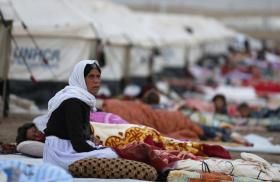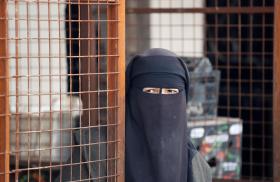

Part of a series: Counterterrorism Lecture Series
or see Part 1: U.S. Efforts against Terrorism Financing: A View from the Private Sector
An intensive discussion with the head of Dutch intelligence covering the role of the Syria campaign, advances by the new generation of European jihadists, and steps officials can take to understand and reduce the threat.
On December 4, Rob Bertholee, the director-general of the Dutch General Intelligence and Security Service (AIVD), addressed a Policy Forum at The Washington Institute to discuss the "sudden and explosive renewal" of jihadism in the Netherlands. The following is a rapporteur's summary of his remarks.
Since the early 2000s, the AIVD has been studying the many forms of jihad in the Netherlands, and in particular violent jihadism. At the beginning of the twenty-first century, Dutch homegrown jihadism was quiet. Small, isolated networks entertained thoughts of jihadism in theory, but in practice their aspirations amounted to little. The role of security services was relatively simple: find the would-be militant and talk him out of it, a method that often worked.
The situation changed completely at the beginning of 2013. Within a few months, more than a hundred jihadists left for Syria. The wave surprised everyone. Present estimates put potential Dutch participants in the Syrian conflict at a few hundred, with several thousand more sympathizers. Of the participants, nineteen have been killed -- three in suicide attacks -- and thirty have returned. Interestingly, a rising number of women and girls, even as young as thirteen, wish to travel to Syria.
At first glance, the Syrian war may seem to have triggered this wave. The country is easy to reach, and the conflict is ideologically attractive for potential jihadists. But Syria is only part of the story. The AIVD has identified four other key developments in play.
First, this sudden explosion took place behind the scenes. The jihadist movement learned from its previous mistakes, becoming more professional in its operations and avoiding unwanted attention. Travelers have learned to lie, telling security services that they're going to a wedding, or to see their nephew, and the government does not have the legal instruments to stop them. Additionally, online and social media networks help facilitate activities like travel or how to make explosives.
Second, Dutch jihadists have learned from their counterparts in Britain and Belgium. They are expressing their opinions in new, provocative yet legal ways. Freedom of speech gives jihadists great leeway, and they are smart enough to avoid potentially criminal rhetoric.
Third is the extent to which the Dutch jihadist movement has embraced social media to spread its message. The improved effectiveness and speed have fundamentally changed interactions. While previous messaging was vertical, from a leader to followers, it is now much more horizontal. Multiple centers mean messages go from many to many, instead of one to many, on a constant basis. The very process of radicalization is much faster.
The fourth development is how Dutch jihadists use social media. The new dynamics of the jihadist movement are swarm-like: decentralized, fast, and fluid. Members act autonomously, but all have a clear understanding of where they want to go. Swarm characteristics have made the jihadist movement stronger and more flexible. Security forces can hamper individual jihadists but cannot have a lasting impact on the movement as a whole.
The religious and ideological context is also important. The Dutch Salafi movement has recently become another jihadist breeding ground. Whereas in previous years dawa, or “call,” Salafists acted as a buffer, advocating nonviolent discourse, many foreign preachers are now speaking outside the mosques and calling for violent jihad. These foreign imams attract many young people, pushing domestic imams to take a more hardline stance to maintain their constituencies. Still, the foreign message is much more radical, and has proven very attractive to susceptible young Muslims. While there has been discussion of licensing imams, this is not the role of the government. Even if it were an option, licenses mean little if youth refuse to listen. Activists are testing the limits of civil rights such as free speech, and their increased professionalism raises the level of difficulty in responding to radicalization.
The profile of a typical jihadist is less uniform than it once was. Most are men in their twenties, often third- or fourth-generation Dutch citizens of Moroccan descent. But the Dutch ancestry of some jihadists goes back centuries -- they are as Dutch as wooden shoes and windmills, yet they still radicalize and go to Syria. Nor are they all uneducated or criminals; they may have university degrees. And it is no longer just fighters leaving for Syria -- families are now going with the intent of living there. Jihadists believe they can build an ideal state under Islamic law in Syria, and some women accompany their husbands or go alone to marry a jihadist already in the region.
Increasing the risk to the Netherlands, most of the Dutch who have gone to Syria have joined groups related to or inspired by al-Qaeda. For many of those groups, the ultimate and common enemy is Western society as a whole. Returning fighters may be traumatized, war-hardened, or explicitly tasked to initiate violent actions by their military commanders, whether against Dutch society in general or specific groups like Jews or Shiites. Free travel within the Schengen Area of Europe makes it even easier for a fighter to move through one country and carry out an attack in any of the twenty-five other Schengen countries. The French militant Mehdi Nemmouche did just that in attacking a Jewish museum in Belgium. He also disguised his return from Syria by flying through Kuala Lumpur to Amsterdam. Even with the thirty Dutch fighters who have so far returned, the AIVD is unable to follow all of them all the time. Some of this responsibility must be shared with the police and municipal institutions.
Internally, there is also concern about the effect on the domestic Dutch jihadist movement. Extremists have intimidated moderate Muslims who speak out against violent jihad. Since the coalition airstrikes began, some Dutch jihadists in Syria have posted pictures of the strikes online and on social media to gain status. There has been a worrying increase in domestic supporters asking about the validity of attacks on certain targets, or the acceptability of collateral damage. However, as young people travel to join the Islamic State of Iraq and al-Sham (ISIS) rather than just fight against Syrian president Bashar al-Assad, parents are getting involved. Many have gone to the police or the AIVD to report fears that their children are radicalizing.
As detailed in the AIVD report The Transformation of Jihadism in the Netherlands, the current plan for addressing the jihadist movement has five chapters. First is risk reduction, such as revoking passports and monitoring the travel of potentially dangerous individuals across borders. Second is intervening in travel when there are serious grounds for concern, especially if children are involved. The third priority is finding and discouraging recruiters, and prosecuting them when possible. The fourth, preventing radicalization, is likely the hardest to realize. The government must engage with the Muslim community and use all of the community's insights and power. Fifth, social media activity is vital. The policy of the Dutch government is to monitor forums and notify providers to take down sites as soon as they are used for spreading radical ideology.
Most important, the AIVD must organize and force cooperation between government institutions. Although the Netherlands is a relatively small country, cooperation does not always come naturally. The AIVD needs to work with the police, the courts, and the military. International cooperation is also vital -- France has had more than a thousand citizens travel to Iraq and Syria; Britain, somewhere between five hundred and one thousand; Germany, more than five hundred. There is still a long way to go in countering radical ideology and understanding what makes it attractive. Unfortunately, that code has not yet been broken. Only when these motivations are understood can there be a reasonable and effective counternarrative.
This summary was prepared by Kelsey Segawa.






